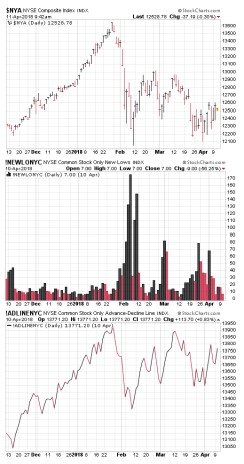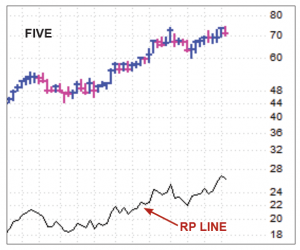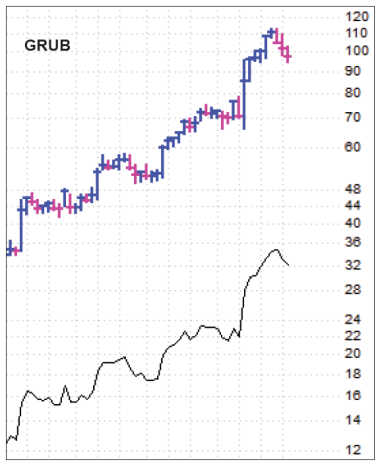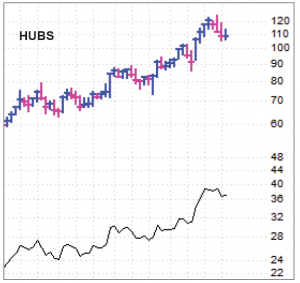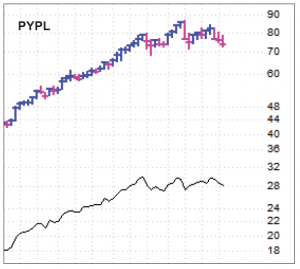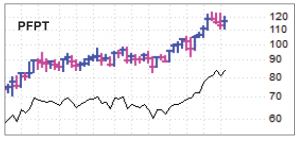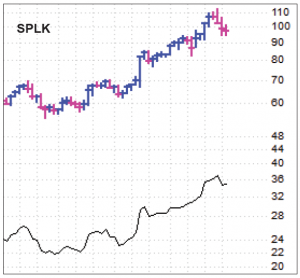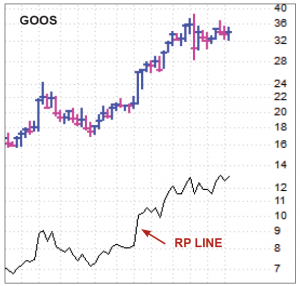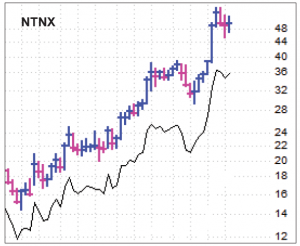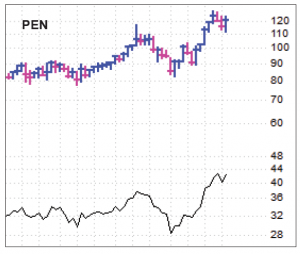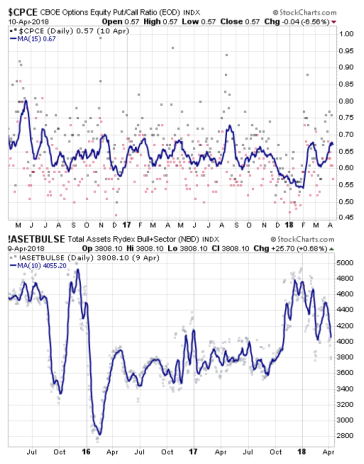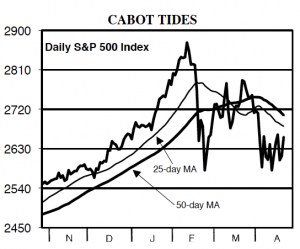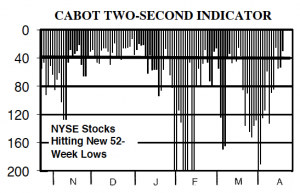We haven’t yet seen the buyers retake control (the intermediate-term trend is down and few stocks are moving up), so we’re sticking with a cautious stance. In the Model Portfolio, we are restoring one Buy rating, but we’re standing pat with 45% cash and are waiting patiently for the trend to turn up.
Cabot Growth Investor 1391
[premium_html_toc post_id="148126"]
Crocuses and Snowdrops
We’ve explained before how our market timing system is divided between the primary indicators (the trends of the major indexes and the action of leading growth stocks) and secondary indicators (things like sentiment, the action of the broad market, divergences and the like).
The primary indicators, of course, are the most important and drive our decisions. In that realm, despite the dramatic volatility and headlines of the past two weeks, nothing has changed. The market’s longer-term trend is still pointed up, and there are a decent number of growth stocks that are holding up well. But the intermediate-term trend is down, few stocks are actually pushing higher and some look downright ragged.
With little money being made by the longs or shorts, we’ve stayed cautious, with nearly half the portfolio in cash, focusing on capital preservation and not trying to game every market wiggle.
That said, we’ve noted some signs of life from a handful of secondary indicators, especially those that track the broad market. Shown here is an updated and expanded chart of what we presented in the last issue—you can see that, even as the NYSE Composite fully retested its February lows, the number of common stocks hitting new lows remained about half its February total, while the Advance-Decline line stayed well above its 2018 lows.
These positive divergences are like the first crocuses or snowdrops of the season—they’re a good sign that winter is likely near an end, but they don’t necessarily mean that it won’t snow this weekend. Thus, our antennae are up for the bulls to retake control, but we’re not likely to do much buying until the primary evidence turns bullish.
As for individual stocks, one thing seems clear: Much of the market’s well-known leadership is tired, while many fresher, newer names (including a bunch that just got going on big volume this year) look resilient. Our bet is that newer leadership will be the winners of the next upmove, so that’s what we’re focused on today.
[highlight_box]WHAT TO DO NOW: Remain cautious, but stay tuned. If the broad market’s resilience leads to a new uptrend, we’ll start putting our cash back to work, but right now we advise patience. In the Model Portfolio, we’re putting Proofpoint back on Buy, but are still holding 45% in cash.[/highlight_box]
Model Portfolio Update
It’s been a super-volatile, news-driven past two weeks, but net-net, the stocks we own and are watching have generally held up well, holding north of key support (their 50-day moving averages or other notable price support) even on days the market gets whacked.
Thanks to that and our good-sized cash position, the Model Portfolio is hanging in there—after gaining 40% last year, we were up 3% for 2018 coming into this week. Nothing to brag about, of course, but better than the indexes and, most importantly, we’re in a good position to build on our gains if and when the market turns up.
As we wrote on page 1, there are some encouraging signs that selling pressures are slowly easing, which often leads to a new rally. But we need to see some real, sustained buying pressure (specifically a buy signal from our Cabot Tides) before adding a bunch of new stocks. Thus, tonight, we’re standing pat, but we’re monitoring both our indicators and potential new leadership for any buy signals.
Current Recommendations
BUY—Five Below (FIVE 76)—FIVE leapt up and out of a 14-week base this week, which is a great sign. We remain optimistic that the combination of the firm’s stellar short- and long-term growth outlook, the stock’s relatively fresh advance (just breaking out in November from a five-year base) and some renewed strength in the retail space (which didn’t do much last year) will bode well going forward. Some subscribers have asked what it means that the company guided to a relatively slow Q2 and Q3 this year, partly due to investment spending and partly due to tough comparisons (the fidget spinner craze was in full effect last spring and summer). Our answer: Probably not much, as big investors tend to focus on the overall growth story when it comes to retail stocks because their growth outlooks are usually durable (at least in comparison to, say, technology stocks). On the downside, we see that since hitting a major low in early 2017, FIVE has found support at or above its 30-week moving average (currently near 64 and rising slowly); thus, a mental stop in the low 60s (call it 61 or 62) makes sense. But we’re sticking with our Buy rating, thinking the stock’s next big move is up—and that move could be starting now if all goes well. Even so, keep new positions on the small side given the market.
HOLD—Grubhub (GRUB 98)—After a huge run during the past few months, GRUB has been pulling back with the market. So far, it’s held north of its 50-day line, which we see as a bullish sign. We wouldn’t be surprised if the stock’s correction goes deeper, allowing shares more time to build a new launching pad. That said, having taken partial profits on half our position, we’re aiming to ride out a longer-term trend that, if management pulls the right levers, could last for years. After re-reading the Q4 conference call transcript this week, we think the scale and potential of a couple of recent deals are likely being underestimated. For instance, when it comes to its partnership with Yum! Brands, zero KFC and Taco Bell restaurants offer delivery services, so integration with the Grubhub platform has enormous potential to boost sales for the restaurants and, of course, dramatically boost business for GRUB. And then there’s the recently completed integration with Yelp (part of its deal to buy Eat24 from that company), which opens up Grubhub’s 80,000-strong restaurant network to Yelp’s huge user base (140 million unique visitors in Q4). If you own some with a profit, sit tight.
BUY—HubSpot (HUBS 112)—HUBS isn’t powerful, but the stock has generally held its 50-day line during the market’s recent leg lower and has been creeping higher in recent days. Big picture, we remain bullish that, due to the recent tax cut (including full expensing of new investments) and booming profits, businesses (including many small- and mid-sized outfits) are finally opening up their wallets and upgrading to solutions like HubSpot’s. Not that business hasn’t been doing well already—revenues have risen sequentially in every quarter since the stock went public in Q3 2013—but 2018 could be a turning point in terms of adoption. A dip by HUBS down to the low 100s would tell us something is wrong and have us cutting our loss. But right here, we’ll stick with our Buy rating.
HOLD—PayPal (PYPL 77)—Competition worries popped up again for PayPal late last week, when reports said that Amazon will be adding a person-to-person payment feature to its Alexa digital assistant. While we’d never underestimate what Amazon can accomplish, the competition fears for PayPal have regularly been overblown. The firm’s various deals with payment operators and banks, as well as its huge (227 million accounts) and active (33.6 transactions per account in Q4; total payment volume of $451 billion in 2017) customer base give it plenty of momentum as payments go digital. Of course, we’ll let the stock tell its own story—a break of support in the 70 to 71 area would have us selling, but we see a good chance PYPL can resume its longer-term uptrend once the market returns to health. The next big move could come down to earnings, which are due out April 25.
BUY—Proofpoint (PFPT 121)—PPFT dipped sharply on March 27, with the market dragging it down nine points on big volume. But since then, the stock has acted very well, holding above its 50-day line and rallying almost all the way back to new highs! Throw in some bullish action from its peers (like FTNT and PANW) and we’re going to restore our Buy rating, thinking the stock could be a mid-cap leader when a sustained market rally gets underway. If you do buy, keep it small, not just because of the market but because of earnings—Proofpoint will release first-quarter results on April 26, with analysts looking for revenue growth of 33% and earnings of 16 cents per share.
HOLD—Shopify (SHOP 120)—SHOP looks more like an egg than a tennis ball lately, as the stock hasn’t bounced much after a sharp, big-volume decline late last month. We are currently holding just a small position and shares are holding above the long-term 200-day line (near 111), so we’d like to give it a chance, possibly holding through earnings (which are due out May 1) to see if buyers reappear. If you have a loss, you could consider paring back here or using a very tight stop. Otherwise, we advise holding on with a mental stop in the 111 area.
HOLD—Splunk (SPLK 102)—SPLK looks like a lot of growth stocks right now—a good run for the first couple of months of the year, a sharp pullback to its 50-day line during the market’s plunge late last month, and a modest rebound (with support at the 50-day) ever since. Our game plan remains the same as it has been (a mental stop near our cost basis of 92, as we don’t want to let a decent profit turn into a loss), but barring a breakdown, we still think SPLK has big potential. At its late-March Investor Day, management laid out a very bullish outlook, with total customers anticipated to grow 30% during the next couple of years, and those new customers should consistently expand their purchases over time (bookings rise four- to five-fold within four years) as past cohorts have done. All told, revenues should grow in the mid-20% range through 2020, while earnings surge at a much faster rate. If you own some, we advise sitting tight.
Watch List
Axon Enterprises (AAXN 43): AAXN remains in good shape, holding its move into new-high ground from a couple of weeks ago. It’s a bit thinly traded but the firm’s body cameras and digital evidence management platform should drive big growth going forward.
Continental Resources (CLR 62): More and more energy stocks are showing life, and CLR looks like a leader, having just broken out of a big 16-month consolidation. Growth is rapid as the company’s drilling activity has picked up with oil prices on the rise.
Dropbox (DBX 32): It’s a brand new stock (public in mid-March), but it has an established business and excellent growth prospects. See below for more.
E*Trade (ETFC 57): We owned ETFC for a bit last year, but got out near breakeven when the market’s correction started 10 weeks ago. But shares have held up extremely well, and the underlying Bull Market story remains solid.
Etsy (ETSY 30): Etsy’s marketplace for homemade goods dominates that niche retail space. The stock has been very resilient, though it’s also had a big run during the past few months.
Floor & Decor (FND 54): FND is another thinner name, but we’re in love with the firm’s cookie-cutter story and potential to take share in the flooring business. The one hitch here could be a potential slowdown in the housing market (if, say, interest rates rise), but the stock isn’t anticipating that, having leapt to new highs last week.
Nutanix (NTNX 52): At this point, NTNX will probably be the first stock we add to the Model Portfolio if we get a new buy signal. See below.
Other Stocks of Interest
The stocks below may not be followed in Cabot Growth Investor on a regular basis. They’re intended to present you with ideas for additional investment beyond the Model Portfolio. For our current ratings on these stocks, see Updates on Other Stocks of Interest on the subscriber website or email mike@cabotwealth.com.
Canada Goose (GOOS 35) — This Toronto-based outerwear company has been tearing up the peapatch since its March 2017 IPO. Canada Goose made its name with high-end down parkas and has been leveraging its premium brand by moving into knitwear accessories and clothing for spring. Revenue growth has been strong—44% in 2015, 33% in 2016 and 39% in 2017—and the company turned profitable in 2015. After coming public at 18 a little over a year ago, GOOS flew to 38 in early February before a disappointing quarterly report dropped it briefly to as low as 28. But since that gap down, GOOS has formed a normal base, tightening up around 35, and is sharing in the improved tone of retail stocks. Good story, and a breakout above 37 would be bullish.
Dropbox (DBX 32) — Dropbox, which started life in 2007 as a file-sharing app, has transformed itself into a global cloud collaboration platform that lets team members store documents, financial records, photos and business information in a secure, accessible way. The company boasts more than 500 million users in over 180 countries and sales topped $1 billion in 2017. DBX just came public three weeks ago at 21, but popped over 30 within a few days, which is where it’s building its post-IPO base. The company isn’t profitable yet, but there’s evidence that institutional investors are clamoring to get on board; T. Rowe Price just reported a 20% stake! There’s not a lot of financial history on Dropbox—40% revenue growth in 2016 and 31% in 2017—but its subscription model keeps recurring revenue high and analysts expect the company to turn profitable in 2018. It’s probably a better stock to watch than to buy right now, but it’s intriguing.
Nutanix (NTNX 52) — Nutanix, the tech company that put “hypercoverged infrastructure” into our vocabulary, has an enterprise cloud platform that puts servers, virtualization programs and storage into one integrated solution. With three years of revenue growth above 80%, the company is in high gear and management expects billings to grow an incredible 40% annually through 2021. As Nutanix moves away from hardware sales, sales growth will slow, but cash flow and earnings will improve. NTNX’s six-week rush from 29 to 55 in February and March set it apart and it’s been holding up well as the market acts fitfully. As we said earlier, when we get a new buy signal, NTNX will be at the top of the list.
Penumbra (PEN 122) — Penumbra is a modestly sized (market cap is $4.2 billion) medical device company whose products are sold in the U.S., Europe, Canada and Australia. The company’s devices are used to clear the blood vessel blockages associated with strokes, heart attacks and deep-vein thrombosis and block vessels with leaks or aneurisms. While PEN can trade choppily, its price advances since its September 2015 IPO at 40 have been exemplary. After a run to 116 last November, PEN fell to 83 in January, despite a lack of any negative news. PEN has rebounded to 123 in recent trading, with a couple of modest pullbacks along the way. Fundamentals are excellent (including a 211% jump in earnings on a 31% climb in revenue in Q4) and after a few quarters of losses from Q4 2016 through Q2 2017, analysts are looking for a big increase in EPS in 2018 (85%) and a 193% jump in 2019.
Fond Farewell to Facebook
One of the reasons the market can be challenging is that it frequently doesn’t act as it “should.”A good earnings report can result in a big gap lower, positive economic news can lead to big selloffs in the broad market and quick, large rallies in the market usually produce even higher prices down the road. In other words, things that seem positive for stocks often lead to selloffs, and vice versa.
A good example of this is what happens after a prolonged rally in the market finally cracks. For example, last Monday, the S&P 500 closed below its 200-day moving average (a common longer-term measuring stick) for the first time since June 2016. That streak (more than 400 trading days) above the 200-day line was one of the longest ever; in fact, even streaks lasting a year are relatively rare.
Conventional wisdom suggests that, after such a big advance, the break of the 200-day line indicates a major trend change, usually because of a change in the fundamentals (in today’s case, the threat of a trade war) that causes all of the big investors to pare back. But, as in so many cases, conventional wisdom is wrong.
According to Schaeffer’s Research, there have been 10 times during the past 55 years that the S&P 500 has been above its 200-day line for at least a year before cracking the key moving average. Following those “breakdowns” the market actually did very well: One month later, the S&P was up an average of 1.6% (seven of 10 occurrences had positive results). Three months later, the average gain was 6.1% (eight of 10). And six months later, the market was up 10% (nine of 10)!
These gains aren’t as counterintuitive as they may seem. Market tops take time and almost always involve a period of degradation (and a loss of momentum) in the broad market. Thus, the first meaningful pullback of a bull move with lots of upside momentum rarely leads to an immediate bear phase.
That doesn’t guarantee that the scenario will work out perfectly this time around, or that you should stay stubbornly bullish despite the selling pressure. But it definitely means you shouldn’t be throwing in the towel or succumbing to all the trade war worries—odds are that, once this correction finishes up, the bull market will resume.
Sentiment: Worried, but No Panic
One of our main thoughts when the market initially took it on the chin in February was that, after a 15-month uptrend with no meaningful pullbacks (the largest S&P 500 “correction” was 3% or so), it would take time for the market to wear and scare out enough investors to embark on a major uptrend. Well, we’re now 10 weeks from the January top, so let’s take a look at a couple of sentiment measures and see what investors are thinking.
The first is a two-year chart of the CBOE equity put-call ratio, along with its 15-day moving average. Two things stick out in this chart. First, the ratio got to a very low (complacent) level during January of this year when the market was going straight up; it was its lowest reading in three and a half years, in fact, and certainly was a sign investors were jubilant.
Second, the ratio has picked up a good amount (indicating growing fear), first during the February market plunge, and again during the recent slide in the indexes. That said, we can’t say the recent readings are all that extreme—the ratio in the upper reaches of its two-year range and nearing its highest level since last summer, but it’s not showing any major panic.
It’s a similar story with the assets in all Rydex bullish and sector funds, which, despite being a relatively small measurement (just a few billion dollars) have a good history of spotting market extremes. This chart shows the 10-day moving average of assets reaching $4.8 billion late last year, the highest level since 2015. The average has fallen off a good amount since then, but is still near the top of the range from mid-2016 through most of 2017.
Of course, there are other sentiment measures, including some that indicate more worry than these two. But overall, investor sentiment seems to be mid-range here—people are worried, and recognize the market has issues, but most aren’t predicting doom and gloom.
What we really want to see is how sentiment reacts going forward. Do investors get super-bullish again if the market rallies? Do they throw in the towel should the market break down from here? Sentiment is always secondary to the action of the market and leading growth stocks, but it should provide a clue to the market’s next big move in the weeks ahead.
Cabot Market Timing Indicators
There are signs that the worst of the market correction could be in the past, including some solid resilience despite bad news from the major indexes and the Two-Second Indicator’s positive divergence. It’s good to see, but we still need to see the intermediate-term Cabot Tides turn positive before starting a new buying spree.
Cabot Trend Lines: Bullish
It’s been a tedious 10 weeks for the major indexes, but our Cabot Trend Lines have stayed bullish throughout. Last week, the S&P 500 did close 0.7% below its 35-week line, but the Nasdaq closed 0.7% above its own trend line—and because a sell signal requires two straight weeks of both indexes closing below their respective trend lines, the indicator (and, thus, the market’s longer-term trend) remains bullish.
Cabot Tides: Bearish
Our Cabot Tides are still negative despite some lift by the major indexes in recent days. The S&P 500 (daily chart shown here) is a good example—while the index has chopped around recently, it’s still below its 25-day and 50-day moving averages. In the near-term, a decisive move above the 50-day line (possibly to 2,725) would be needed for a Buy signal. (That could change if the market has another leg down, of course.) Bottom line, the intermediate-term trend continues to point down.
Two-Second Indicator: Unhealthy
As we showed on page 1, our Two-Second Indicator is spotting some positive divergences in the broad market. That said, today was just the second day of fewer than 40 new lows seen over the past few weeks. Thus, it’s too soon to conclude that selling pressure on the broad market has vanished; that will come if we see five or six days in a row of sub-40 readings.
[premium_html_footer]
Send questions or comments to mike@cabotwealth.com.
Cabot Growth Investor • 176 North Street, Post Office Box 2049, Salem, MA 01970 • www.cabotwealth.com
All Cabot Growth Investor’s buy and sell recommendations are made in issues or updates and posted on the Cabot subscribers’ website. Sell recommendations may also be sent to subscribers as special bulletins via email and the recorded telephone hotline. To calculate the performance of the portfolio, Cabot “buys” and “sells” at the midpoint of the high and low prices of the stock on the day following the recommendation. Cabot’s policy is to sell any stock that shows a loss of 20% in a bull market (15% in a bear market) from our original buy price, calculated using the current closing (not intra-day) price. Subscribers should apply loss limits based on their own personal purchase prices.
Charts show both the stock’s recent trading history and its relative performance (RP) line, which shows you how the stock is performing relative to the S&P 500, a broad-based index. In the ideal case, the stock and its RP line advance in unison. Both tools are key in determining whether to hold or sell.
THE NEXT CABOT GROWTH INVESTOR WILL BE PUBLISHED APRIL 25, 2018
We appreciate your feedback on this issue. Follow the link below to complete our subscriber satisfaction survey: Go to: www.surveymonkey.com/marketlettersurvey
Neither Cabot Wealth Network nor our employees are compensated by the companies we recommend. Sources of information are believed to be reliable, but are in no way guaranteed to be complete or without error. Recommendations, opinions or suggestions are given with the understanding that subscribers acting on the information assume all risks. © Cabot Wealth Network. Copying and/or electronic transmission of this report is a violation of U.S. copyright law. For the protection of our subscribers, if copyright laws are violated, the subscription will be terminated. To subscribe or for information on our privacy policy, call 978-745-5532, visit www.cabotwealth.com or write to support@cabotwealth.com.
[/premium_html_footer]

